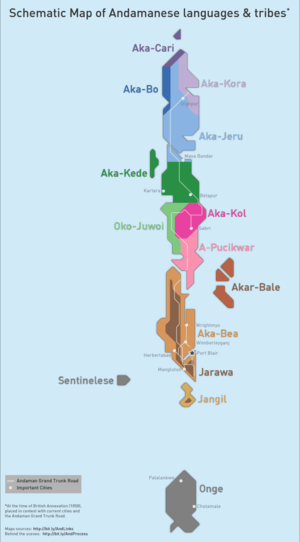Akar-Bale language
The Bale language, Akar-Bale (also Balwa), is an extinct Southern[3] Great Andamanese language once spoken in the Andaman Islands in Ritchie's Archipelago, Havelock Island, and Neill Island.
| Bale | |
|---|---|
| Akar-Bale | |
| Native to | India |
| Region | Andaman Islands; Ritchie’s Archipelago, Havelock Island, Neill Island. |
| Extinct | between 1931 and 1951[1] |
Great Andamanese
| |
| Language codes | |
| ISO 639-3 | acl |
| Glottolog | akar1243[2] |
 | |
History
The Bale disappeared as a distinct people sometime after 1931.[1]
Grammar
The Great Andamanese languages are agglutinative languages, with an extensive prefix and suffix system.[4] They have a distinctive noun class system based largely on body parts, in which every noun and adjective may take a prefix according to which body part it is associated with (on the basis of shape, or functional association). Thus, for instance, the *aka- at the beginning of the language names is a prefix for objects related to the tongue.[4] An adjectival example can be given by the various forms of yop, "pliable, soft", in Aka-Bea:[4]
- A cushion or sponge is ot-yop "round-soft", from the prefix attached to words relating to the head or heart.
- A cane is ôto-yop, "pliable", from a prefix for long things.
- A stick or pencil is aka-yop, "pointed", from the tongue prefix.
- A fallen tree is ar-yop, "rotten", from the prefix for limbs or upright things.
Similarly, beri-nga "good" yields:
- un-bēri-ŋa "clever" (hand-good).
- ig-bēri-ŋa "sharp-sighted" (eye-good).
- aka-bēri-ŋa "good at languages" (tongue-good.)
- ot-bēri-ŋa "virtuous" (head/heart-good)
The prefixes are,
| Bea | Balawa? | Bajigyâs? | Juwoi | Kol | |
|---|---|---|---|---|---|
| head/heart | ot- | ôt- | ote- | ôto- | ôto- |
| hand/foot | ong- | ong- | ong- | ôn- | ôn- |
| mouth/tongue | âkà- | aka- | o- | ókô- | o- |
| torso (shoulder to shins) | ab- | ab- | ab- | a- | o- |
| eye/face/arm/breast | i-, ig- | id- | ir- | re- | er- |
| back/leg/butt | ar- | ar- | ar- | ra- | a- |
| waist | ôto- |
Body parts are inalienably possessed, requiring a possessive adjective prefix to complete them, so one cannot say "head" alone, but only "my, or his, or your, etc. head".
The basic pronouns are almost identical throughout the Great Andamanese languages; Aka-Bea will serve as a representative example (pronouns given in their basic prefixal forms):
| I, my | d- | we, our | m- |
| thou, thy | ŋ- | you, your | ŋ- |
| he, his, she, her, it, its | a | they, their | l- |
'This' and 'that' are distinguished as k- and t-.
Judging from the available sources, the Andamanese languages have only two cardinal numbers — one and two — and their entire numerical lexicon is one, two, one more, some more, and all.[4]
See also
References
- George van Driem (2001), Languages of the Himalayas: An Ethnolinguistic Handbook of the Greater Himalayan Region : Containing an Introduction to the Symbiotic Theory of Language, BRILL, ISBN 90-04-12062-9,
... The Aka-Kol tribe of Middle Andaman became extinct by 1921. The Oko-Juwoi of Middle Andaman and the Aka-Bea of South Andaman and Rutland Island were extinct by 1931. The Akar-Bale of Ritchie's Archipelago, the Aka-Kede of Middle Andaman and the A-Pucikwar of South Andaman Island soon followed. By 1951, the census counted a total of only 23 Greater Andamanese and 10 Sentinelese. That means that just ten men, twelve women and one child remained of the Aka-Kora, Aka-Cari and Aka-Jeru tribes of Greater Andaman and only ten natives of North Sentinel Island ...
- Hammarström, Harald; Forkel, Robert; Haspelmath, Martin, eds. (2017). "Akarbale". Glottolog 3.0. Jena, Germany: Max Planck Institute for the Science of Human History.
- Manoharan, S. (1983). "Subgrouping Andamanese group of languages." International Journal of Dravidian Linguistics XII(1): 82-95.
- Temple, Richard C. (1902). A Grammar of the Andamanese Languages, being Chapter IV of Part I of the Census Report on the Andaman and Nicobar Islands. Superintendent's Printing Press: Port Blair.